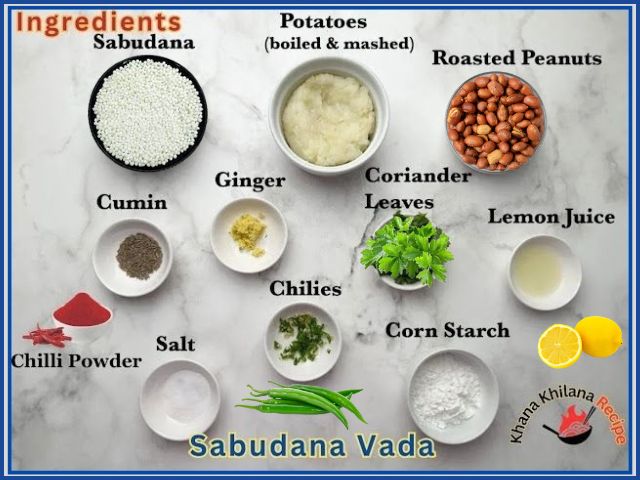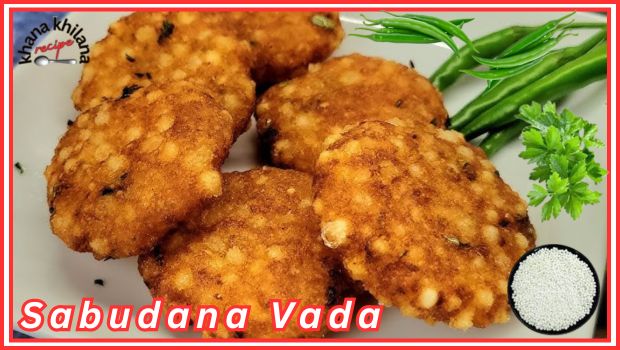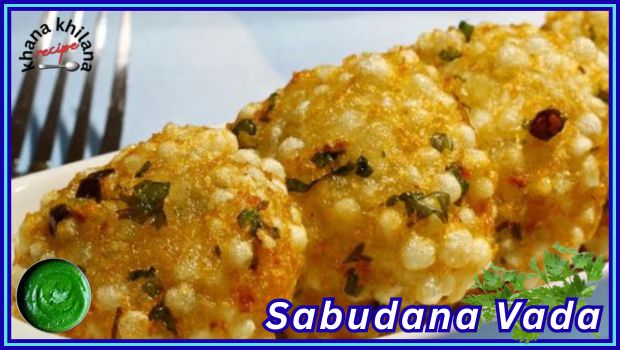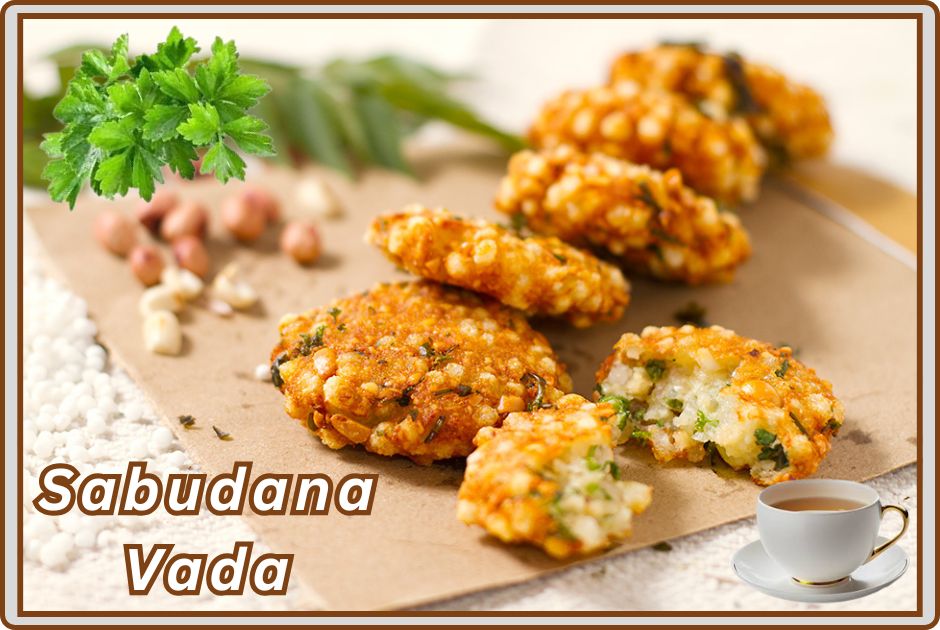Introduction – Hello friends, welcome to the Khana Khilana Recipe blog. Today, we’ll share a crispy recipe made from sabudana (sago). Sabudana vada a special dish eaten during Navratri and other fasts in India, is a delicious and crunchy dish.
September 27, 2025, marks the sixth day of the sacred Navratri fast dedicated to Goddess Bhagwati. The festival of Navratri is celebrated with great pomp and gaiety throughout India. In most Hindu households, mothers and sisters observe a fast for nine days.
A variety of dishes are prepared during the Navratri fast, among which sabudana vada is a traditional staple in many homes. Sabudana vada is crispy on the outside and delicious on the inside. It was originally made in the western region of Maharashtra, India, and gradually spread throughout India.
This special sabudana vada is traditionally made and eaten at home during Navratri fasts, as well as other sacred fasts like Shivratri and Janmashtami.
To make sabudana vada, sabudana is washed in clean water and soaked for a while to soften. Grated boiled potatoes are mixed with sabudana, coarsely ground peanuts, chopped green chilies, cumin seeds, and finely chopped coriander leaves, along with aromatic spices. A soft dough is kneaded. Round balls are formed and flattened into tikkis. These are then shallow-fried, deep-fried, or roasted.
Once ready, serve hot with green coriander mint chutney, fresh yogurt, or with tea. So, let’s make this delicious, crunchy fasting sabudana vada recipe.
Preparation Time – 15 – 20 Minutes
Soaking Time 3 – 4 Hours
Cook Time – 30 – 35 Minutes
Total Time – 45 Minutes
Servings – 4 + Serv
Cuisine – Maharashtrian Indian

Sabudana Vada Ingredients:
- Sabudana – 1 cup (Sago)
- Potato – 4 (400 gm, Boiled and grated )
- Peanuts – 75 gm (Roasted and coarsely ground)
- Cumin Seeds – 1 teaspoon
- Green Chili – 2 (finely chopped)
- Ginger – 1 inch (finely chopped)
- Lemon – Half
- Salt – 1 teaspoon (as per taste)
- Red Chili Powder – 1 teaspoon (as par tested)
- Cooking Oil – 500 gm
- Green Coriander Leaves – 2 tablespoons (finely chopped)
Sabudana Vada Direction:
Step 1
First, mash the sago thoroughly with clean water and soak it in water for three to four hours. If you have time, you can soak the sago for the whole night. When the sago is soaked in water for 4 hours and has doubled in size, then drain out all the water spread it on a kitchen towel, and dry it slightly.
Step 2
Wash 400 grams of potatoes thoroughly, put them in the cooker, add enough water to submerge the potatoes by one inch, add one teaspoon of salt, cover with a lid, and keep it to boil. It takes three or four whistles for the potatoes to boil. When your potatoes are boiled, open the lid and drain out all the water. After the potatoes cool down, then peel them and grate them.
Step 3
Place a non-stick pan on the flame and roast the peanuts on medium flame while stirring with a spoon. When the peanuts are roasted well, turn off the flame and after the peanuts cool down, crush with hands and remove the peel put them in a mixer grinder jar, and grind them coarsely.

Step 4
Now take a big bowl, add dried sago, grated potatoes, coarse peanuts, finely chopped coriander leaves, cumin seeds, salt as per taste, red chili powder as per taste finely chopped ginger, add the juice of half a lemon, and all mix well with the hands.
Step 5
After mixing the mixer well, clean your hands apply a little oil on both the blades, and make small balls using the mixer with your hands. After making the balls round with the help of your palm, give them a slightly flat tikki-like shape. Make tikki using all the mixers in the same manner.
Step 6
Now place a non-stick pan over the flame and pour cooking oil inside it. When the cooking oil gets heated properly, test it by adding a light mixer. If the mixer immediately rises to the top of the cooking oil, then it means that the oil is cooked properly. Once it is hot, put as many tikis as you can fit inside the hot oil at one time.
Step 7
Let the tikkis fry inside the oil. Do not stir immediately with a spoon. After about 1 minute, gently turn the tikkis with the help of a spoon and fry them golden from the other side as well. When the Sabudana Vadas are well fried from both sides, take them out on kitchen paper turn all the leftover Vadas upside down in the oil, and fry them until golden. So, our Sabudana Vada is ready with green coriander, mint chutney, and fresh curd and served hot.
To taste delicious green coriander and mint greens, check out our Hara Bhara Kebab recipe, the link of which we are giving below.
Hara Bhara Kabab Recipe https://khanakhilanarecipe.in/2024/01/Hara-Bhara-Kabab-Recipe.html

Tips And Notes
1 – For the Sabudana Vada recipe, small-sized sago should be taken and while soaking it in water, keep in mind that it should be soaked in a big vessel with plenty of water because sago swells and becomes large in quantity. If there is less water then lumps remain. it doesn’t bloom properly.
2 – Roasted peanuts are also available in the market. You can grind roasted peanuts from the market, then you will not have to roast raw peanuts and your time will also be saved.
3 – Sometimes the potato gets overboiled and there is excessive moisture inside it. If this happens then you can add buckwheat flour or water chestnut flour inside it and tighten the mixer. If you are not making Sabudana Vada for the fast. If you are having it then you can also add corn starch in it.
4 – If you prefer to eat less grease, then you can also shallow fry the Sabudana Vada. For that, put some ghee in a non-stick flat pan and fry the Sabudana Vada tikki golden shallow from both sides.
Faq
Q: What is sago made from?
Ans: Sago does not come in the category of grains. It is made from the stem of a tree called Sago Palm by a special process that takes 2 to 3 days. The Sago Palm tree is very tall like the palm tree and it is a plant native to East Africa. In India, sago is made from the roots of plants called cassava and tapioca, and in eastern countries, it is made from the stem of the sago palm tree.
Q: What are the benefits of eating sago?
Ans: Nutrients like magnesium and calcium are available in abundance in sago, the consumption of which strengthens our bones. When it is time for teething to happen to small children, it is beneficial to feed them products made from sago. Along with boosting energy, sago is also helpful in our digestion process.
Q: What is the right time to eat sago?
Ans: Most of the dishes made from sago are consumed during the Navratri fast and other religious fasts for an energy boost. It has a lot of fiber in it, and it is easy to digest. You can eat it any time of the day, in the morning, at breakfast, at lunch, at dinner, or before sleeping at night. Consuming it with milk is very beneficial. If you have any stomach-related problems then definitely consult your doctor before eating this.

You May Also Like ⇓
Sama Chawal Khichdi Recipe https://khanakhilanarecipe.in/2023/10/Sama-Chawal-Khichdi-Recipe.html
Aloo Ka Halwa Recipe https://khanakhilanarecipe.in/2023/10/Aloo-Ka-Halwa-Recipe.html
Sabudana Kheer Recipe https://khanakhilanarecipe.in/2023/10/Sabudana-KheerRecipe.html
Kuttu Ke Pakode Recipe https://khanakhilanarecipe.in/2023/10/Kuttu-Ke-Pakode-Recipe.html
Sabudana Khichdi Recipe https://khanakhilanarecipe.in/2023/07/Sabudana-Khichdi-Recipe.html
In Conclusion
Welcome to the Khana Khilana Recipe Blog. Today we have told you about Sabudana Vada. In this recipe, We told you to wash the sago with clean water, soak it in water for four to five hours or overnight, boil the potatoes, peel them, grate them, roast the peanuts, grind them coarsely, soak the sago, grated potatoes and coarse Put peanuts in a bowl, add cumin seeds, finely chopped green chilies, finely chopped ginger, finely chopped coriander, and salt and mix well. Make round balls of Sabudana Vada put cooking oil in a non-stick pan and deep fry them. Fry golden, when ready serve hot with green coriander, mint chutney, and fresh curd. we hope you enjoy this recipe. Which recipe do you want to know about please write us our next recipe on the blog will be the same. do write to us for any kind of advice and suggestion. we respect your valuable suggestion. Thank you.

Sabudana Vada / Nutrition Value
Per Serving one vada (60 gm)
Fat➡ 10.6 gm
Carbs➡ 9.4 gm
Protein➡ 1.8 gm

Hello, I am Rajeev Sharma. We welcome you to the khana khilana recipe blog. I share easy tips for cooking delicious and quick recipes on my blog. My aim is to share the art of cooking new and different types of tasty recipes with my readers so that their cooking experience becomes very easy.


Pingback: Sabudana Chivda / Fasting Special Namkeen Recipe - From Kitchen to Table: Exploring the World of Flavors
Pingback: Moong Dal Pakoda - From Kitchen to Table: Exploring the World of Flavors